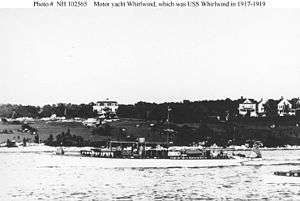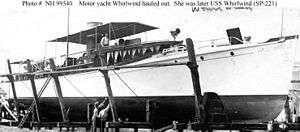USS Whirlwind (SP-221)
 | |
| History | |
|---|---|
| Name: | USS Whirlwind |
| Namesake: | Previous name retained |
| Builder: | Charles L. Seabury Company and Gas Engine and Power Company, Morris Heights, the Bronx, New York |
| Completed: | 1909 |
| Acquired: | 11 May 1917 |
| Commissioned: | 26 June 1917 |
| Decommissioned: | 8 December 1917 |
| Recommissioned: | 29 September 1918 |
| Decommissioned: | 3 December 1918 |
| Struck: | 24 April 1919 |
| Fate: | Sold 30 June 1919 |
| Notes: | Operated as civilian yacht Whirlwind 1909-1917 |
| General characteristics | |
| Type: | Patrol vessel |
| Tonnage: | 59 gross tons |
| Length: | Either 111 ft (34 m)[1] or 117 ft (36 m) [2] |
| Beam: | 12 ft (3.7 m) |
| Draft: | 3 ft 6 in (1.07 m) mean |
| Propulsion: | Steam engine, three shafts |
| Speed: | 20 knots |
| Armament: |
|
The first USS Whirlwind (SP-221) was a United States Navy patrol vessel in commission in 1917 and again in 1918.
Construction, acquisition, and commissioning
Whirlwind was built as a civilian wooden-hulled, triple-screw, steam yacht of the same name in 1909 by the Charles L. Seabury Company and the Gas Engine and Power Company at Morris Heights in the Bronx, New York. The U.S. Navy purchased her from her owner, Julius Fleischmann of New York City, on 11 May 1917 for World War I service as a patrol vessel. She was commissioned at the New York Navy Yard at Brooklyn, New York, as USS Whirlwind (SP-219) on 26 June 1917 with Lieutenant, junior grade, A. S. Johnstone, USNRF, in command.
World War I service
First period in commission, 1917
Whirlwind fitted out at the Charles L. Seabury Company shipyard, then arrived at New Haven, Connecticut, on 17 August 1917. She soon commenced patrols off the Cornfield Point lightship. Her duties included hailing passing vessels and seeing that they kept within their designated channels and that other section patrol boats were on their stations. She also escorted Allied ships through the nets that guarded those waters. In the course of one of her normal cruises, she prevented the steamer SS Noreg, out of Nova Scotia, Canada, from fouling the antisubmarine net during a heavy squall on 24 August 1917. Early in September 1917 she inspected the 11th Division of the 3rd Naval District's local patrol forces on station in Long Island Sound.
By early September 1917, it had become apparent that Whirlwind's sea-keeping qualities left much to be desired. Her heavy rolling and pitching caused the Navy to cease using her as an offshore patrol vessel. She arrived at the Charles L. Seabury Company shipyard at Morris Heights on 13 September 1917 for overhaul, then was decommissioned at the Marine Basin at Brooklyn on 8 December 1917.
Second period in commission, 1918
Reconsidered for naval use in a different nautical environment, Whirlwind was recommissioned at Waukegan, Illinois, on 29 September 1918. Operating out of Naval Training Station Great Lakes at Great Lakes, Illinois, she cruised to Waukegan and Chicago, Illinois, and to Milwaukee and Manitowoc, Wisconsin, before proceeding to Detroit, Michigan. During this time, she made three cruises on Lake Michigan with family members of Naval Training Station Great Lakes commandant Captain William A. Moffett—a Medal of Honor recipient, future rear admiral, and future Chief of the Navy's Bureau of Aeronautics—embarked.
Final disposition
After her arrival at detroit, Whirlwind was decommissioned there on 3 December 1918. She was stricken from the Navy List on 24 April 1919 and sold on 30 June 1919.
Notes
- ↑ Per the Naval History and Heritage Command Online Library of Selected Images (at http://www.history.navy.mil/photos/sh-civil/civsh-w/whirlwnd.htm),
- ↑ Per the Dictionary of American Naval Fighting Ships (at http://www.history.navy.mil/research/histories/ship-histories/danfs/w/whirlwind.html) and NavSource Online (at http://www.navsource.org/archives/12/170221.htm).
References
- This article incorporates text from the public domain Dictionary of American Naval Fighting Ships. The entry can be found here.
- Department of the Navy: Navy History and Heritage Command: Online Library of Selected Images: Civilian Ships: Whirlwind (American Motor Yacht, 1909). Served as USS Whirlwind (SP-221) in 1917-1919
- NavSource Online: Section Patrol Craft Photo Archive: Whirlwind (SP 221)
